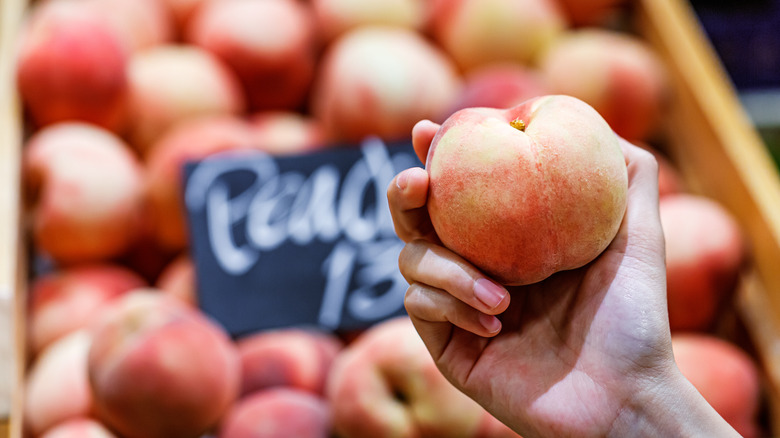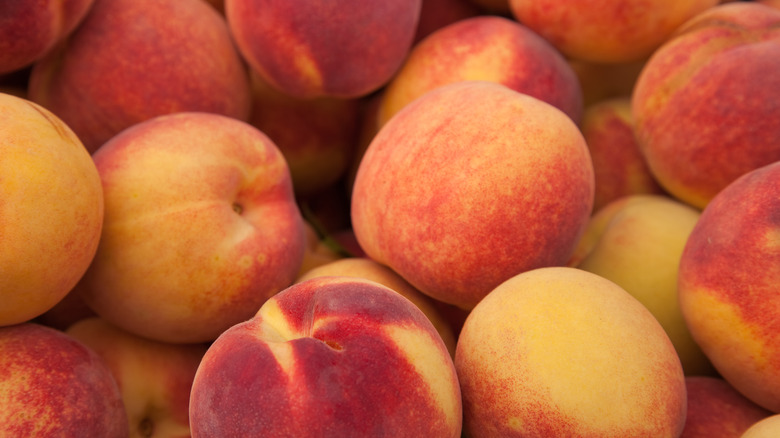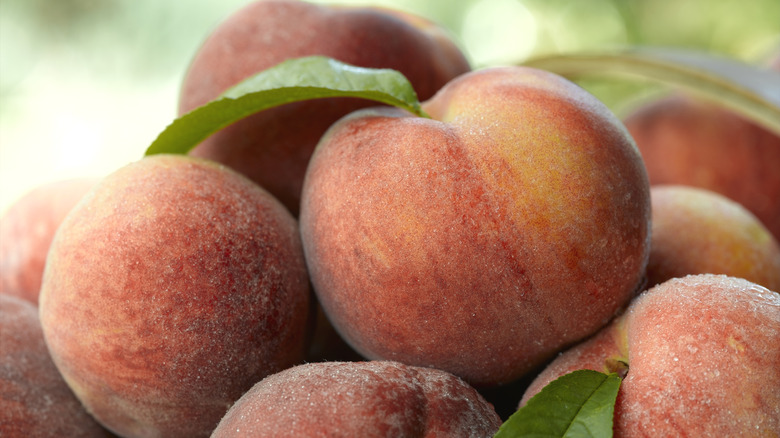How To Choose The Tastiest Peaches At The Grocery Store
Peaches are pure heaven in edible fruit form, but it can seem like a crapshoot guessing how to pick the ripest ones from the grocery. Whether you prefer the succulent stone fruit tucked into a sweet peach-blackberry crumble or layered into a freshly baked peach cobbler and topped with a dollop of whipped cream — they're delicious no matter which way you choose to eat them. Unless — that is — you happen to pick up the wrong one at the supermarket. After all, bite into an unripe peach, and it will usually be lacking in the taste department — void of its signature sweet, juicy flavor. Similarly, although they're usually very sweet, the overripe ones can be just as unsatisfying because they're often too mushy. And a rotten peach? Forget about it.
In order to ensure your purchase is a good one, there are a few things to look out for when picking a ripe drupe. Namely, you want to pay attention to the color, shape, and feel of the pit-bearing fruit. A delicious, ready-to-eat peach will be deep gold in color, round in shape, and have a slight give to it when squeezed.
The yellow peaches are better
Peaches are usually in season from about May through late September, meaning the summer months are prime picking season. Although a sweet-smelling aroma is usually a good indication that the fruit is ready to be enjoyed, it's not always the best measure of ripeness. When perusing the fruit section of your local grocery store for the ripest choice, there are a handful of visual clues to check for — the first of which is color.
Widely known for their reddish hue, the red parts of the fruit are actually caused by sunlight exposure. Even though your eyes may be drawn to the reddest varieties, the ripest peaches will actually feature more of a dark, golden-yellow color, especially around the stems because the leaves tend to provide shade against the sun. If the peach is green — or yellow with hints of green — that means it's underripe. You may be tempted to snag a few, especially if you don't plan on eating them right away. However, it's good to note that peaches are only able to ripen over time if they weren't picked too soon. Those harvested too early generally don't continue to mature after they've been separated from the tree. So they may get softer, but they likely won't be more delicious.
Check shape and softness, too
There's absolutely no shame in judging a peach by the way that it looks, so pay attention to the shape. One that's ready to eat will be rounder and plumper — whereas an unripened peach will have more of an ovular shape. However, appearance isn't the only indicator of a ripened drupe; the feel of the fruit is also incredibly important, too. With that in mind, another great way to gauge its level of ripeness is by the way that it feels.
In particular, you want to be mindful of how hard or soft it is. Since they get juicier as they ripen, one that's just right will feel soft between the fingertips when you give it a gentle squeeze. Just be sure not to grasp it too tightly because the fuzzy skin is very delicate and can be prone to bruising. Unsurprisingly, it will feel quite hard or firm if it's underripe and feel mushy or squishy if it's overripe.
Now that you know how to pick the perfect peach while out grocery shopping, just make sure you know the best way to store peaches when you bring them home, too. Your cobbler never tasted better.



